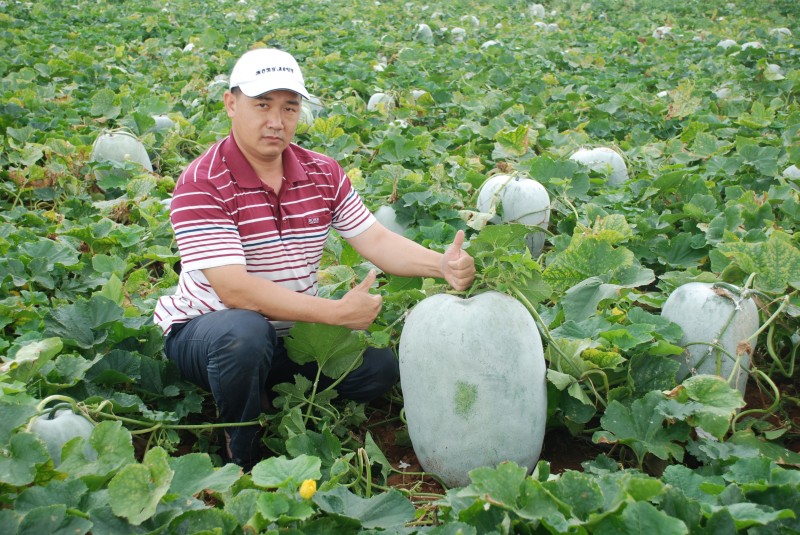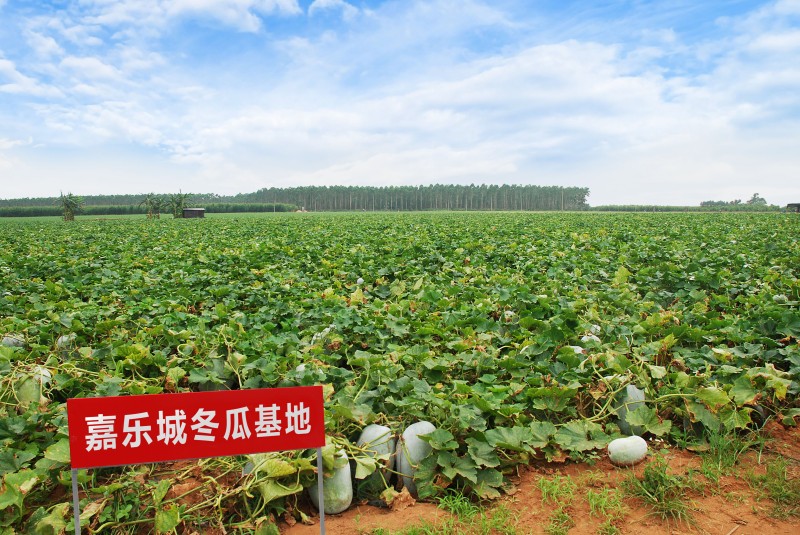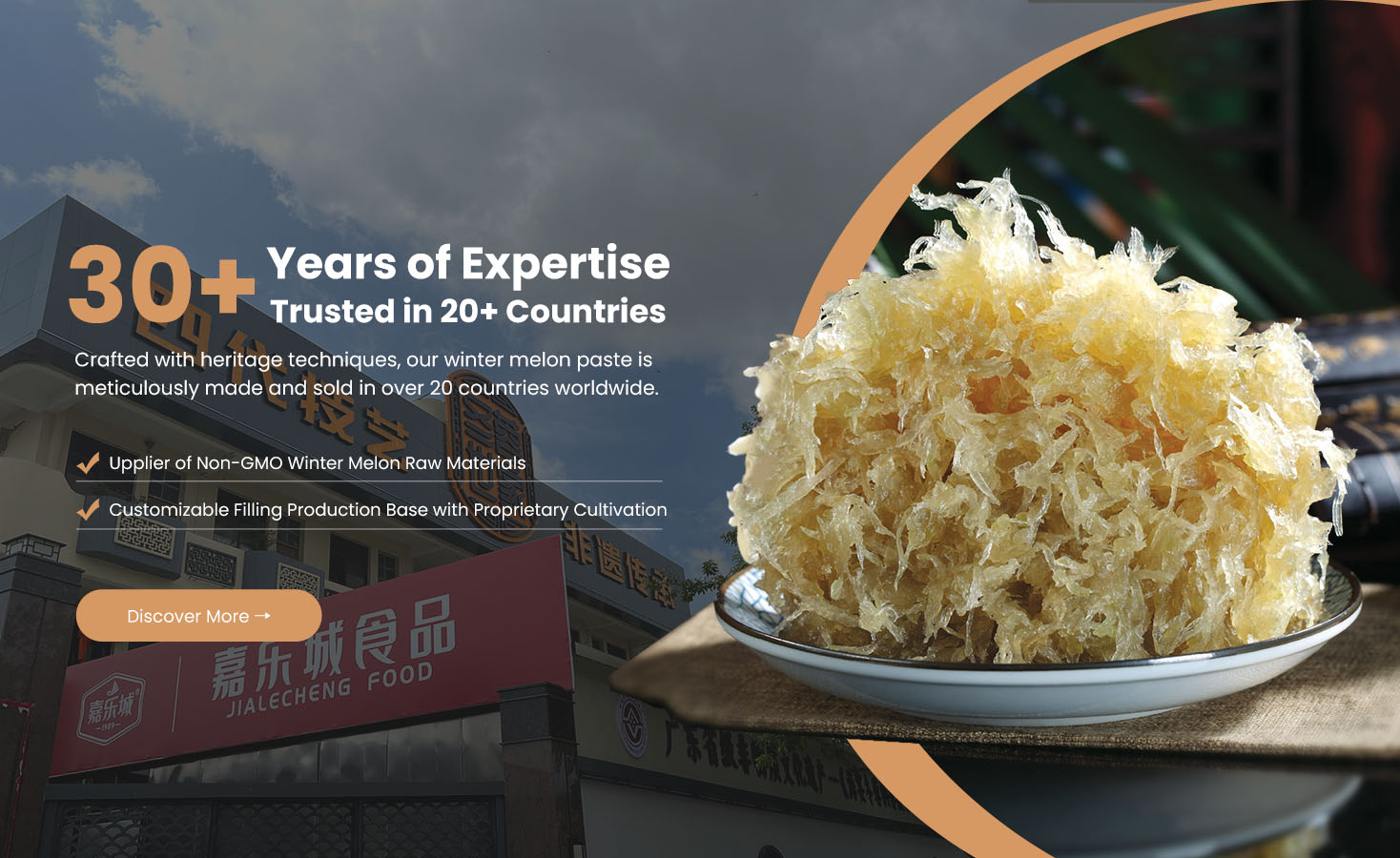1.1 Description of filling process for winter melon paste
1. Raw material acceptance: The raw material is winter melon produced in Chonglou Town, Taishan City, from farmers who have signed planting and sales agreements with the company. Adopting the "company+farmer" model for management, the company provides winter melon seeds to farmers and regularly supervises and manages the planting site, inspecting its planting and medication situation.
2. Pre treatment: including steps such as cleaning, peeling, shredding, and dehydration of raw materials.
3.Dehydration: Use clean and hygienic dehydration equipment to perform centrifugal dehydration treatment on the raw materials.
4. Ingredients: Accurately weigh flour, sugar, oil, food additives, etc. according to the product formula, and mix and stir them.The use of food additives must comply with GB standards and the import country's limit standards for food additives.
5. Boiling: Use a heating device to heat the prepared filling for 30-40 minutes at a temperature of 200-210 ℃. The center temperature of the product should reach 85 ℃.
6. Room temperature cooling: Use clean and hygienic trays for loading and cool at room temperature.
7 Packaging: Use packaging containers to package the cooled filling, divided into aerobic packaging and anaerobic packaging
8. Metal detection: Use metal detectors to detect the filling package by package, FeΦ2.0,SusΦ3.0。
9. Storage: Store at room temperature in the warehouse.
10 Auxiliary Material Acceptance: Qualified suppliers from the factory with corresponding product processing qualifications, providing qualified product inspection reports for each batch, and ensuring complete product packaging.
11. Acceptance of food additives:
Qualified suppliers from the factory with corresponding product production qualifications, providing qualified product inspection reports for each batch;
It is prohibited to purchase food additives or non food additives that are prohibited by the country or importing country.
12 Packaging material acceptance: Qualified suppliers from the factory with corresponding product production qualifications, providing qualified product inspection reports for each batch.
13. Dry storage: Store in a dry and ventilated place before use.

2.2 Process description of winter melon paste mooncakes
1. Raw material acceptance: The raw material is wheat flour, sourced from qualified suppliers in the factory.
2. Pre treatment: Use a sieve to screen the wheat flour.
3. Ingredients: Accurately weigh and prepare flour, sugar, oil, food additives, etc. according to the product formula. The use of food additives must comply with GB standards and the import country's limit standards for food additives.
4. Leather making: Use a dough mixer to mix and stir the ingredients for 5-10 minutes to make dough.
5. packs of filling: According to production requirements, wrap a certain amount of filling and egg kernels into the prepared dough.
6. Molding: Use mooncake molding molds to press and shape.
7. Baking:
Spray the surface of mooncakes evenly with a water sprayer before putting them into the oven;
Preheat the converter to a furnace temperature of 230 ℃, pre bake mooncakes for 9-12 minutes, cool them for 2 minutes after leaving the furnace, and then brush the egg mixture;
Open hearth temperature, with an upper heat of 210 ℃ and a lower heat of 160 ℃. Bake in the oven for about 9 minutes, with a center temperature above 85 ℃.
8. Room temperature cooling: Natural cooling at room temperature.
9. Packaging: Use packaging containers to package the cooled mooncakes, divided into aerobic packaging and anaerobic packaging.
10. Metal Detection: Use a metal detector to detect the filling package by package, FeΦ2.0,SusΦ3.
11. Storage: Store at room temperature in the warehouse.
12. Auxiliary Material Acceptance: Provided by qualified suppliers of the factory with corresponding product processing qualifications, providing qualified product inspection reports for each batch, and ensuring complete product
packaging.
13. Acceptance of Food Additives:
Provided by qualified suppliers of the factory, with corresponding production qualifications, and providing qualified product inspection reports for each batch.
It is prohibited to purchase food additives or non food additives that are prohibited by the country or importing country.
14 Winter Melon Paste Filling Outbound: The finished winter melon paste filling is outbound and ready to enter the next process.
15 points picking: Divide the whole winter melon filling into a certain amount of small pieces according to production requirements.
16 Egg Yolk Acceptance: Provided by qualified suppliers of the factory, processing plants with export filing qualifications provide qualified product inspection reports for each batch.
17. Fresh egg acceptance: Provided by qualified suppliers of the factory, breeding farms with export registration qualifications shall provide qualified product inspection reports for each batch.
18. Cleaning and Disinfection: Clean and disinfect the shell of fresh eggs.
19. Egg mixture preparation: Separate the fresh eggshell liquid, mix the egg white and yolk evenly to form a starchy egg mixture.
20. Packaging Material Acceptance: Provided by qualified suppliers of the factory, with corresponding product production qualifications, and qualified product inspection reports provided for each batch.
21. Dry storage: Store in a dry and ventilated place before use.

3.3 Description of Winter Melon Paste Pastry Process
1. Raw material acceptance: The raw material is wheat flour, sourced from qualified suppliers in the factory.
2. Pre treatment: Use a sieve to screen the wheat flour
3. Ingredients: Accurately weigh and prepare flour, sugar, oil, food additives, etc. according to the product formula. The use of food additives must comply with GB standards and the import country's limit standards for food additives.
4. Leather making: Use a dough mixer to mix and stir the ingredients for 5-10 minutes to make dough.
5. packs of filling: According to production requirements, wrap a certain amount of filling and egg kernels into the prepared dough.
6. Molding: Use pastry molding molds to press and shape.
7. Baking:
Spray the surface of the pastry evenly with a water sprayer before putting it into the oven;
Preheat the converter to a furnace temperature of 230 ℃, bake the pastry for 9-12 minutes, cool it for 2 minutes after leaving the furnace, and then brush the egg mixture;
Open hearth temperature, with an upper heat of 210 ℃ and a lower heat of 160 ℃. Bake in the oven for about 9 minutes, with a center temperature above 85 ℃.
8. Room temperature cooling: Natural cooling at room temperature.
9. Packaging: Use packaging containers to package the cooled pastries, divided into aerobic packaging and anaerobic packaging.
10. Metal Detection: Use a metal detector to detect the filling package by package, FeΦ2.0,SusΦ3.0.
11. Storage: Store at room temperature in the warehouse.
12. Auxiliary Material Acceptance: Provided by qualified suppliers of the factory with corresponding product processing qualifications, providing qualified product ins




